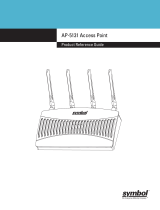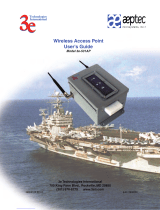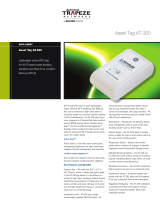Page is loading ...

SPECIFICATION SHEET
Wireless LAN (WLAN) switch/controller and
voice communications platform
The RFS6000 Enterprise WLAN Switch/controller
from Motorola enables the wireless enterprise
by offering an integrated WLAN communication
platform that delivers secure and reliable voice, video
and data applications. Designed on the innovative
and modular Wi-NG operating system, the RFS6000
provides wired and wireless networking services,
multiple locationing technologies such as Wi-Fi
and RFID; resiliency via 3G/4G wireless broadband
backhaul; and high performance with 802.11n
networks. The enterprise class RFS6000 delivers
the best in class performance, security, scalability
and manageability required to meet the needs of
demanding mission critical business applications.
Cost-effective centralized management
Based on Motorola’s landmark Wireless Next
Generation (Wi-NG) operating system, the RFS6000
provides the tools you need to simplify and minimize
the costs associated with real-time management of
mobility solutions. The Wi-NG architecture provides
unified management of network hardware, software
configuration, and network policies, complete with
built-in process monitors and troubleshooting tools.
In conjunction with the RF Management Suite (sold
separately), the RFS6000 provides centralized control
over the entire lifecycle of your Motorola mobility
solution — allowing you to easily design, deploy,
monitor and secure your wireless network.
FEATURES
Wi-NG Operating System
— delivering a unified
voice, data and RF
management platform
Improve business process flow
with one platform for wireless
voice, video, data and multiple
RF technologies — such as
RFID, Wi-Fi (including 802.11n)
and future technologies such
as Wi-MAX; rich enterprise-
class functionality includes
seamless roaming across
L2/L3 deployments,
resilient failover capabilities,
comprehensive security,
toll-quality voice and other
value-added services, such
as multi-RF locationing
Role-based wired/
wireless firewall
Comprehensively secures and
protects the wired and wireless
network against attacks and
unauthorized access at Layer
2 and Layer 3 with stateful
inspection; ability to create
identity and location-based
policies provides granular
control of network access
Raising the bar on enterprise class
performance and network resiliency
The RFS6000 offers a multicore, multithreaded
Wi-NG architecture capable of supporting 2,000 to
20,000 mobile devices and up to 48 dual radio 802.11
a/b/g thin access points or 256 adaptive access
points (AP-5131 a/b/g or AP-7131 a/b/g/n) per switch/
controller. Motorola’s patent pending clustering
technology allows a 12X capacity increase, for build-
as-you-grow networks. The result is an architecture
that is purpose-built to deliver high availability
— and scalability. In addition, a user accessible
ExpressCard™ Slot supports 3G broadband cards
for a redundant wireless WAN backhaul connection,
providing a truly self-sustainable wireless enterprise.
Gap-free security for the Wireless Enterprise
Comprehensive network security features keep
wireless transmissions secure and provide
compliance for HIPAA and PCI. The RFS6000 provides
gap-free security for the WLAN network, following
a tiered approach to protect and secure data at
every point in the network, wired or wireless. This
complete solution includes a wired/wireless firewall,
a built-in wireless intrusion protection system (IPS),
an integrated IPSec VPN gateway, AAA Radius
Server and secure guest access with a captive web
portal, reducing the need to purchase and manage
additional infrastructure. Additional security features
include MAC-based authentication, 802.11w to secure
management frames, NAC support, anomaly analysis
and more.
RFS6000
Enabling a secure and reliable Wireless
Enterprise for medium to large deployments
Wireless LAN Switch/Controller

2
Adaptive AP: extending
the enterprise
Enables centralized
management of mesh
access points at remote
sites including automatic
firmware upgrades;
provides site survivability
for remote locations with
802.11a/b/g/n networks for
unparalleled resiliency
SMART RF Management
Next generation self-
healing: enables the
WLAN to automatically
and intelligently adapt
to changes in the RF
environment to eliminate
unforeseen gaps in coverage
Wireless Intrusion
Prevention System
The built-in WIPS system
provides defense against
over-the-air attacks by
leveraging the sensing
capabilities of AP300/
AP51x1/AP7131
Real Time Locationing
System (RTLS)
Provides rich locationing
services to enable real-time
enterprise asset-tracking
through support for
802.11, RFID and third
party locationing solutions
— including industry
leaders AeroScout, Ekahau,
and Newbury Networks.
Standards-based support
for: EPC Global ALE
interface for processing and
filtering data from all active
and passive tags; and EPC
Global LLRP interface for
passive RFID tag support
Clustering and
failover features
Supports multiple levels
of redundancy and failover
capabilities to ensure
high availability networks;
provides a single virtual IP
(per VLAN) for the cluster
for use as default gateway
by mobile devices/wired
infrastructure, on-board
DHCP/AAA server
synchronized failover; multi-
platform license sharing
enables deployment of
cost-effective networks
RFS6000 network architecture
The RFS6000 offers the comprehensive functionality necessary to extend wireless voice, video and data
access inside medium to large enterprises — as well as to remote locations such as branch offices.

Enabling toll-quality voice for
the Wireless Enterprise
Support for VoWLAN provides cost-effective voice
services throughout the wireless enterprise,
enabling push-to-talk and more for employees
inside the four walls as well as outside. The rich
feature set provides granular control over the many
wireless networking functions required to deliver
high performance persistent clear connections with
toll-quality voice. Quality of Service (QoS) ensures
superior performance for voice and video services.
WMM Admission Control, including TSPEC, SIP
Call Admission Control, and 802.11k radio resource
management, ensures dedicated bandwidth for voice
calls as well as better control over active voice calls
for a variety of VoIP handsets. In addition, the fixed
mobile convergence (FMC) ready RFS6000 provides
support for third-party solutions and future services,
including the extension of the desk phone to mobile
devices over the WLAN and WWAN.
Adaptive AP for increased network
flexibility — and site survivability
The RFS6000 simplifies and reduces the cost of
extending mobility to remote and branch offices as
well as telecommuters. Motorola’s Independent Mesh
Access Points (AP-51X1 a/b/g and AP-7131 a/b/g/n) can
be deployed at remote locations yet centrally managed
in the Network Operations Center (NOC) through the
RFS6000 (single switch or a cluster for scalability).
An IPSec VPN tunnel secures all traffic between the
access points and the wireless switch. Remote Site
Survivability (RSS) mesh access points deliver secure
uninterrupted wireless service — providing unparalleled
resiliency that survives a WAN link outage.
Put your RF on autopilot
The Wi-NG architecture delivers SMART RF
Management, which provides the dynamic RF tuning
required for optimal network performance. This feature
takes self-healing to the next level, dramatically reducing
network monitoring IT costs by enabling the WLAN to
intelligently adapt to the ever-changing RF environment.
The ability to dynamically adjust the power and channels
on any thin access point automatically eliminates the
gaps in coverage that occur when an AP fails or there
is a change in your environment — for example, the
introduction of an increased volume of liquid or metal
— all without any physical intervention. The elegant
feature protects against under- or over-powering —
scenarios that could reduce performance and network
availability. And adjustments are completely transparent
— there is no impact on voice calls and data sessions
in progress — protecting the quality of service and the
user experience to ensure user productivity.
Maximize benefits — and minimize costs
All the enterprise class services such as security, voice,
performance and resiliency are built into the Wi-NG
architecture — the innovative and modular operating
system (OS) for the RFS6000. These comprehensive
services come at no additional cost and are packaged
together to make mobility work — even better.
End-to-end support
As an industry leader in mobility, Motorola offers the
experience gained from deploying mobility solutions
all over the globe in many of the world’s largest
enterprises. Leverage this expertise through Motorola
Enterprise Mobility Services, which provides the
comprehensive support programs you need to deploy
and maintain your RFS6000 at peak performance.
Motorola recommends protecting your investment with
‘Service from the Start Advance Exchange Support’, a
multi-year program that provides the next-business-day
device replacement , technical software support and
software downloads you need to keep your business
running smoothly and productively. This service also
includes ‘Comprehensive Coverage’, which covers
normal wear and tear, as well as internal and external
components damaged through accidental breakage —
significantly reducing your unforeseen repair expenses.
For more information, visit us on the web at
www.motorola.com/rfs6000 or access our
global contact directory at
www.motorola.com/enterprisemobility/contactus
3
RFS6000 Specifications
Packet Forwarding
802.1D-1999 Ethernet bridging; 802.11-.802.3 bridging; 802.1Q VLAN tagging and
trunking; proxy ARP; IP packet steering-redirection
Wireless Networking
Wireless LAN: Supports 32 WLANs; multi-ESS/BSSID traffic segmentation;
VLAN to ESSID mapping; auto assignment of VLANs
(on RADIUS authentication); power save protocol
polling; pre-emptive roaming; VLAN Pooling and
dynamic VLAN adjustment; IGMP Snooping
Bandwidth management: Congestion control per WLAN; per user based on user
count or bandwidth utilization; dynamic load balancing
of AP300s and Adaptive APs in a cluster; bandwidth
provisioning via AAA server
Layer 2 or Layer 3 deployment of thin access ports and Adaptive AP AP-51X1 802.11a/
b/g and AP-7131 802.11a/b/g/n access points
Layer 3 Mobility (Inter-Subnet Roaming)
IPv6 client support
Thin Access Ports: Supports 1-48 “thin” 802.11a/b/g AP300 access points
for L2 or L3 deployment per RFS6000 Switch/controller
and 576 802.11a/b/g AP300s per cluster; Legacy
support: AP100 for L2 deployments only
Adaptive AP:
Supports adoption of 256 adaptive AP-51X1 802.11a/b/g
and AP-7131 802.11a/b/g/n access points in adaptive
mode per RFS6000 Switch/controller and 3,072 per
cluster; multiple country configuration support; Legacy
support: AP-4131 port conversion for L2 deployments only
3G Wireless for WAN
Backhaul
Support for 3G wireless
cards to backhaul WAN
traffic when the primary
WAN Link fails
Enhanced End-to-End
Quality of Service (QoS)
Enhances voice and
video capabilities;
prioritizes network traffic
to minimize latency and
provide optimal quality
of experience; SIP Call
Admission Control and
Wi-Fi Multimedia
Extensions (WMM-Power
Save) with Admission
Control enhances
multimedia application
support and improves
battery life and capacity;
network optimization
through granular
bandwidth contracts based
on bandwidth utilization
network load and number
of users for different
applications being used, in
different locations; TSPEC
Admission Control ensures
ample bandwidth and a
superior user experience
for VoIP calls
True mobility
Virtual AP provides better
control of broadcast traffic
and enables multiple
mobile and wireless
applications with quality
of service when network
is congested; Pre-emptive
Roaming ensures Motorola
mobile devices roam before
signal quality degrades;
Power Save Protocol
optimizes battery life
Continued on back

motorola.com
Part number SS-RFS6000. Printed in USA 09/09. MOTOROLA and the Stylized M Logo are registered in the US Patent & Trademark Office. All other product or service names are
the property of their respective owners. ©2009 Motorola, Inc. All rights reserved. For system, product or services availability and specific information within your country, please
contact your local Motorola office or Business Partner. Specifications are subject to change without notice.
Power-over-Ethernet: Integrated; up to 29.7 watts per Ethernet port, up to a
maximum of 180 watts for simultaneous operation
Radio frequency automatic channel select (ACS); Transmit power control
management (TPC); Country code-based RF configuration; 802.11b, 802.11g
802.11a, and 802.11n
Network Security
Role-based wired/wireless firewall (L2-L7) with stateful inspection for wired and
wireless traffic; Active firewall sessions — 100,000 per RFS6000 Switch/controller
and 1,200,000 per cluster; protects against IP Spoofing and ARP Cache Poisoning
Access Control Lists (ACLs): L2/L3/L4 ACLs
Wireless IDS/IPS: Multi-mode rogue AP detection, Rogue AP
Containment, 802.11n Rogue Detection, Ad-Hoc
Network Detection, Denial of Service protection
against wireless attacks, client blacklisting, excessive
authentication/association; excessive probes;
excessive disassociation/deauthentication; excessive
decryption errors; excessive authentication failures;
excessive 802.11 replay; excessive crypto IV failures
(TKIP/CCMP replay); Suspicious AP, Authorized device
in ad-hoc mode, unauthorized AP using authorized
SSID, EAP Flood, Fake AP Flood, ID theft, ad-hoc
advertising Authorized SSID
Geofencing: Add location of users as a parameter that defines
access control to the network
WIPS sensor conversion: Supported on the AP300 and the Adaptive AP-5131
and AP-7131
Anomaly Analysis: Source Media Access Control (MAC) = Dest MAC;
Illegal frame sizes; Source MAC is multicast; TKIP
countermeasures; all zero addresses
Authentication: Access Control Lists (ACLS); pre-shared keys (PSK);
802.1x/EAP—transport layer security (TLS), tunneled
transport layer security (TTLS), protected EAP (PEAP);
Kerberos Integrated AAA/RADIUS Server with native
support for EAP-TTLS, EAP-PEAP (includes a built in
user name/password database; supports LDAP), and
EAP-SIM
Transport encryption: WEP 40/128 (RC4), KeyGuard, WPA—TKIP, WPA2-
CCMP (AES), WPA2-TKIP
802.11w: Provides origin authentication, integrity, confidentiality
and replay protection of management frames for
Motorola’s AP300 access point
IPSec VPN gateway: Supports DES, 3DES and AES-128 and AES-256
encryption, with site-to-site and client-to-site
VPN capabilities; supports 1,024 concurrent IPSEC
tunnels per switch — 12,288 per cluster
Secure guest Local Web based authentication; URL redirection for
access (Hotspot user login; customizable login/welcome pages;
provisioning): support for external authentication/billing systems,
usage-based charging
Wireless RADIUS User Based VLANs (Standard)
Support (Standard and MAC Based Authentication (Standard)
Motorola Vendor User Based QoS (Motorola VSA)
Specific Attributes): Location Based Authentication (Motorola VSA)
Allowed ESSIDs (Motorola VSA)
NAC support with third party systems from Microsoft and Symantec
Real Time Locationing System (RTLS)
RSSI based triangulation for Wi-Fi assets
Tags supported: Ekahau, Aeroscout, Newbury, Gen 2 Tags
RFID support: Compliant with LLRP protocol. Built-in support for
the following Motorola RFID readers: fixed (XR440,
XR450, XR480; mobile (RD5000) and handheld
(MC9090-G RFID)
Optimized Wireless QoS
RF priority: 802.11 traffic prioritization and precedence
Wi-Fi Multimedia WMM-power save with TSPEC Admission Control;
extensions: WMM U-APSD
IGMP snooping: Optimizes network performance by preventing flooding
of the broadcast domain
SIP Call Admission Control: Controls the number of active SIP sessions initiated
by a wireless VoIP phone
802.11k: Provides radio resource management to improve client
throughput (11k client required)
Classification Layer 1-4 packet classification; 802.1p VLAN priority;
and marking: DiffServ/TOS
System Resiliency and Redundancy
Active:Standby; Active:Active and N+1 redundancy with access port and MU load
balancing; Critical resource monitoring
Virtual IP: Single virtual IP (per VLAN) for a switch/contoller cluster to use as the
default gateway by mobile devices or wired infrastructure
SMART RF: Network optimization to ensure user quality of experience at all times
by dynamic adjustments to channel and power (on detection of RF interference or
loss of RF coverage/neighbor recovery)
Dual Firmware bank supports Image Failover capability
System Extensibility
ExpressCard
™
Slot: Driver support for 3G wireless cards for WAN backhaul
• AT&T (NALA) – Option GT Ultra Express
• Verizon (NALA) – Verizon Wireless V740 Express Card
• Vodaphone (EMEA) – Novatel Merlin XU870
• Vodaphone (EMEA) – Vodaphone E3730 3G Expresscard
• Telstra (Australia) – Telstra Turbo 7 series Expresscard (Aircard 880E)
• General Use (NALA/APAC) – Novatel Merlin XU870
PCI-X interface
Management
Command line interface (serial, telnet, SSH); secure Web-based GUI (SSL) for
the wireless switch and the cluster; SNMP v1/v2/v3; SNMP traps—40+ user
configurable options; Syslog; TFTP Client; secure network time protocol (SNTP);
text-based switch configuration files; DHCP (client/server/relay), switch auto-
configuration and firmware updates with DHCP options; multiple user roles (for
switch access); MIBs (MIB-II, Etherstats, wireless switch specific monitoring and
configuration); Email notifications for critical alarms; MU naming capability
Physical Characteristics
Form factor: 1U Rack Mount
Dimensions: 1.75 in. H x 17.32 in. W x 15.39 in. D
44.45 mm H x 440 mm W x 390.8 mm D
Weight: 14 lbs./6.35 kg
Physical interfaces: 1x Uplink Port -10/100/1000 Cu/ Gigabit SFP interface
8x 10/100/1000 Cu Ethernet Ports with 29.7 Watts PoE,
802.3af and 802.3at Draft
1x 10/100 Management Interface (OOB port)
1x USB 2.0 Host
1x ExpressCard
™
Slot (in USB mode)
1X PCI-X Interface
1x Serial Port (RJ45 style)
MTBF: >65,000 Hours
Power Requirements
AC input voltage: 90 – 264 VAC 50/60 Hz
Max AC input 6A@115 VAC, 3A@230 VAC
current:
Input frequency: 47 Hz to 63 Hz
User Environment
Operating temperature: 32° F to 104° F /0° C to 40° C
Storage temperature: -40° F to 158° F/-40° C to 70° C
Operating humidity: 5% to 85% (w/o condensation)
Storage humidity: 5% to 85% (w/o condensation)
Heat dissipation: 665 BTU per hour
Regulatory
Product safety: UL / cUL 60950-1, IEC / EN60950-1
EMC compliance: FCC (USA), Industry Canada, CE (Europe), VCCI (Japan),
C-Tick (Australia/New Zealand)
Recommended Enterprise Mobility Services
Customer Services: Service from the Start Advance Exchange Support
SPECIFICATION SHEET
RFS6000
Enabling a secure and reliable Wireless Enterprise for medium to large deployments
RFS6000 Part Numbers:
RFS-6010-100R0-WR:
Zero Port Wireless Switch
RFS-6010-10010-WR:
8 Port Wireless Switch
RFS-6010-10030-WR:
24 Port Wireless Switch
RFS-6010-10060-WR:
48 Port Wireless Switch
RFS-6010-UC-08-WWR:
8 Port RFS6000 Series
Upgrade Certificate
RFS-6010-ADSEC-LIC:
RFS6000 License for
Advanced Security
RFS-6010-ADP-128:
RFS6000 Licenses for 128
Adaptive Access Points
RFS-6010-ADP-16:
RFS6000 Licenses for 16
Adaptive Access Points
RFS-6010-ADP-256:
RFS6000 Licenses for 256
Adaptive Access Points
RFS-6010-APPL-LIC:
RFS6000 License for the
Location Application License
RFS-3G-BKHL-LIC:
RFS6000 License for Wireless
WAN support
/



